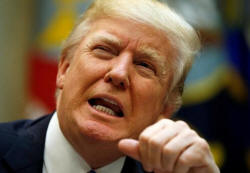|
Military wins in first
Trump budget; environment, aid lose big
 Send a link to a friend
Send a link to a friend
 [March 16, 2017]
By Roberta Rampton [March 16, 2017]
By Roberta Rampton
WASHINGTON
(Reuters) - President Donald Trump will ask the U.S. Congress for
dramatic cuts to many federal programs as he seeks to bulk up defense
spending, start building a wall on the border with Mexico and spend more
money deporting illegal immigrants.
In a federal budget proposal with many losers, the Environmental
Protection Agency and State Department stand out as targets for the
biggest spending reductions. Funding would disappear altogether for 19
independent bodies that count on federal money for public broadcasting,
the arts and regional issues from Alaska to Appalachia.
Trump's budget outline is a bare-bones plan covering just
"discretionary" spending for the 2018 fiscal year starting on Oct. 1. It
is the first volley in what is expected to be an intense battle over
spending in coming months in Congress, which holds the federal purse
strings and seldom approves presidents' budget plans.
Congress, controlled by Trump's fellow Republicans, may reject some or
many of his proposed cuts. Some of the proposed changes, which Democrats
will broadly oppose, have been targeted for decades by conservative
Republicans.
For a graphic on winners and losers in Trump's budget, click
http://fingfx.thomsonreuters.com/gfx/rngs/USA-TRUMP-BUDGET/0100405W0DC/

Moderate Republicans have already expressed unease with potential cuts
to popular domestic programs such as home-heating subsidies, clean-water
projects and job training.
Trump is willing to discuss priorities, said White House budget director
Mick Mulvaney, a former South Carolina congressman who made a name for
himself as a spending hawk before Trump plucked him for his Cabinet.
"The president wants to spend more money on defense, more money securing
the border, more money enforcing the laws, and more money on school
choice, without adding to the deficit," Mulvaney told a small group of
reporters during a preview on Wednesday.
"If they have a different way to accomplish that, we are more than
interested in talking to them," Mulvaney said.
Trump wants to spend $54 billion more on defense, put a down payment on
his border wall, and breathe life into a few other campaign promises.
His initial budget outline does not incorporate his promise to pour $1
trillion into roads, bridges, airports and other infrastructure
projects. The White House has said the infrastructure plan is still to
come.
The defense increases are matched by cuts to other programs so as to not
increase the $488 billion federal deficit. Mulvaney acknowledged the
proposal would likely result in significant cuts to the federal
workforce.
"You canít drain the swamp and leave all the people in it," Mulvaney
said.

'AMERICA FIRST'
White House officials looked at Trump's campaign speeches and "America
First" pledges as they crunched the numbers, Mulvaney said.
"We turned those policies into numbers," he said, explaining how the
document mirrored pledges to spend more on the U.S. nuclear weapons
arsenal, veterans' health care, the FBI, and Justice Department efforts
to fight drug dealers and violent crime.
[to top of second column] |

President Trump looks up during a meeting about healthcare at the
White House. REUTERS/Kevin Lamarque

The Department of Homeland Security would get a 6.8 percent increase,
with more money for extra staff needed to catch, detain and deport
illegal immigrants.
Trump wants Congress to shell out $1.5 billion for the border wall with
Mexico in the current fiscal year - enough for pilot projects to
determine the best way to build it - and a further $2.6 billion in
fiscal 2018, Mulvaney said.
The estimate of the full cost of the wall will be included in the full
budget, expected in mid-May, which will project spending and revenues
over 10 years.
Trump has vowed Mexico will pay for the border wall, which the Mexican
government has flatly said it will not do. The White House has said
recently that funding would be kick-started in the United States.
The voluminous budget document will include economic forecasts and
Trump's views on "mandatory entitlements" - big-ticket programs like
Social Security and Medicare, which Trump vowed to protect on the
campaign trail.
BIGGEST LOSERS
Trump asked Congress to slash the EPA by $2.6 billion or more than 31
percent, and the State Department by more than 28 percent or $10.9
billion.
Mulvaney said the "core functions" of those agencies would be preserved.
Hit hard would be foreign aid, grants to multilateral development
agencies like the World Bank and climate change programs at the United
Nations.
Trump wants to get rid of more than 50 EPA programs, end funding for
former Democratic President Barack Obama's signature Clean Power Plan
aimed at reducing carbon dioxide emissions, and cut renewable energy
research programs at the Energy Department.
Regional programs to clean up the Great Lakes and Chesapeake Bay would
be sent to the chopping block.

Community development grants at the Housing Department - around since
1974 - were cut in Trump's budget, along with more than 20 Education
Department programs, including some funding program for before- and
after- school programs.
Anti-poverty grants and a program that helps poor people pay their
energy bills would be slashed, as well as a Labor Department program
that helps low-income seniors find work.
Trump's rural base did not escape cuts. The White House proposed a 21
percent reduction to the Agriculture Department, cutting loans and
grants for wastewater, reducing staff in county offices and ending a
popular program that helps U.S. farmers donate crops for overseas food
aid.
(Additional reporting by Richard Cowan; Editing by Peter Cooney)
[© 2017 Thomson Reuters. All rights
reserved.] Copyright 2017 Reuters. All rights reserved. This material may not be published,
broadcast, rewritten or redistributed. |